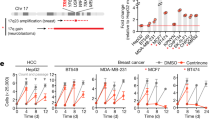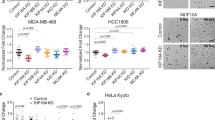Abstract
p53 undergoes phosphorylation on several residues in response to cellular stresses that include UV and ionizing radiation, however the influence of spindle damage on this parameter is relatively unclear. Consequently, the effect of nocodazole on serine 392 phosphorylation was examined in two epithelial cell lines. We show that this process is dependent upon the stepwise activation of p38 mitogen-activated protein kinase (p38 MAPK) and protein kinase casein kinase 2 (CK2). Furthermore, this activation correlated with the biochemical regulation of the maturation-promoting factor (MPF, cdc2/cyclin B), as both DRB and antisense depletion of CK2, as well as SB203580 were associated with an inhibition of its activation in response to nocodazole. Strikingly, when the cell cycle characteristics of nocodazole treated cells were examined, we observed that depletion or inhibition of the catalytic subunit of CK2, in the presence of microtubule inhibitors, resulted in a compromise of the G2 arrest (spindle checkpoint). Furthermore, CK2-depleted, nocodazole treated cells demonstrated a dramatic reduction in the apoptotic cell fraction, confirming that these cells had been endowed with oncogenic properties. These changes were observed in both HeLa cells and HCT116 cells. We also show that this effect is dependent on the presence of functional wild-type p53, as this phenomenon is not apparent in HCT116 p53−/− cells. Collectively, our results indicate two novel roles for CK2 in the spindle checkpoint arrest, in concert with p53. Firstly, to maintain increased cyclinB/cdc2 kinase activity, as a component of G2 arrest, and secondly, a role in p53-mediated apoptosis. These findings may have implications for an improved understanding of abnormalities of the spindle checkpoint in human cancers, which is a prerequisite for defining future therapies.
This is a preview of subscription content, access via your institution
Access options
Subscribe to this journal
Receive 50 print issues and online access
$259.00 per year
only $5.18 per issue
Buy this article
- Purchase on Springer Link
- Instant access to full article PDF
Prices may be subject to local taxes which are calculated during checkout






Similar content being viewed by others
Change history
16 April 2002
An Erratum to this paper has been published: https://doi.org/10.1038/sj.onc.1205097
References
Allende JE, Allende CC . 1995 FASEB J. 9: 313–323
Appel K, Wagner P, Boldyreff B, Issinger OG, Montenarh M . 1995 Oncogene 11: 1971–1978
Atherton-Fessler S, Liu F, Gabrielli B, Lee MS, Peng CY, Piwnica-Worms H . 1994 Mol. Biol. Cell 5: 989–1001
Baker SJ, Markowitz S, Fearon ER, Willson JK, Vogelstein B . 1990 Science 249: 912–915
Bunz F, Dutriaux A, Lengauer C, Waldman T, Zhou S, Brown JP, Sedivy JM, Kinzler KW, Vogelstein B . 1998 Science 282: 1497–1501
Butz K, Shahabeddin L, Geinsen C, Spitkovsky D, Ullmann A, Hoppe-Seyler F . 1995 Oncogene 18: 2381–2386
Butz KN, Whitaker N, Denk C, Ullmann A, Geisen C, Hoppe-Seyler F . 1999 Oncogene 18: 2381–2386
Cahill DP, Lengauer C, Yu J, Riggins GJ, Willson JK, Markowitz SD, Kinzler KW, Vogelstein B . 1998 Nature 392: 300–330
Chan TA, Hermeking H, Lengauer C, Kinzler KW, Vogelstein B . 1999 Nature 401: 616–620
Clarke AR, Purdie CA, Harrison DJ, Morris RG., Bird CC, Hooper ML, Wyllie AH . 1993 Nature 362: 849–852
Cross SM, Sanchez CA, Morgan CA, Schimke MK, Ramel S, Idzerda RL, Raskind WH, Reid BJ . 1995 Science 267: 1353–1356
Di Leonardo A, Khan SH, Linke SP, Greco V, Seidita G, Wahl GM . 1997 Cancer Res. 57: 1013–1019
Dulic V, Kaufmann WK, Wilson SJ, Tlsty TD, Lees E, Harper JW, Elledge SJ, Reed SI . 1994 Cell 76: 1013–1023
Finlay CA, Hinds PW, Levine AJ . 1989 Cell 57: 1083–1093
Fiscella M, Ullrich SJ, Zambrano N, Shields MT, Lin D, Lees-Miller SP, Anderson CW, Mercer WE, Appella E . 1993 Oncogene 8: 1519–1528
Gotz C, Scholtes P, Prowald A, Schuster N, Nastainczyk W, Montenarh M . 1999 Mol. Cell. Biochem. 191: 111–120
Gu W, Roeder RG . 1997 Cell 90: 595–606
Hall SR, Campbell LE, Meek DW . 1996 Nucleic Acids Res. 24: 1119–1126
Hao M, Lowy AM, Kapoor M, Deffie A, Liu G, Lozano G . 1996 J. Biol. Chem. 271: 29380–29385
Haupt Y, Maya R, Kazaz A, Oren M . 1997 Nature 387: 296–299
Hermeking H, Lengauer C, Polyak K, He TC, Zhang L, Thiagalingam S, Kinzler KW, Vogelstein B . 1997 Mol. Cell 1: 3–11
Herrmann CP, Kraiss S, Montenarh M . 1991 Oncogene 6: 877–884
Huang C, Ma WY, Maxiner A, Sun Y, Dong Z . 1999 J. Biol. Chem. 274: 12229–12235
Huang LC, Clarkin KC, Wahl GM . 1996 Cancer Res. 56: 2940–2944
Hupp TR, Meek DW, Midgley CA, Lane DP . 1992 Cell 71: 875–886
Innocente SA, Abrahamson JL, Cogswell JP, Lee JM . 1999 Proc. Natl. Acad. Sci. USA 96: 2147–2152
Jin P, Gu Y, Morgan DO . 1996 J. Cell. Biol. 134: 963–970
Kapoor M, Lozano G . 1998 Proc. Natl. Acad. Sci. USA 95: 2834–2837
Khosravi R, Maya R, Gottlieb T, Oren M, Shiloh Y, Shkedy D . 1999 Proc. Natl. Acad. Sci. USA 96: 14973–14977
Ko LJ, Prives C . 1996 Genes Dev. 10: 1054–1072
Kubbutat MH, Jones SN, Vousden KH . 1997 Nature 387: 299–303
Landesman-Bollag E, Channavajhala PL, Cardiff RD, Seldin DC . 1998 Oncogene 16: 2965–2974
Lanni JS, Jacks T . 1998 Mol. Cell. Biol. 18: 1055–1064
Lees-Miller SP, Sakaguchi K, Ullrich SJ, Appella E, Anderson CW . 1992 Mol. Cell. Biol. 12: 5041–5049
Levine AJ . 1997 Cell 88: 323–331
Li X, Nicklas RB . 1995 Nature 373: 630–632
Liu F, Stanton JJ, Wu Z, Piwnica-Worms H . 1997 Mol. Cell. Biol. 17: 571–583
Lowe SW, Ruley HE, Jacks T, Housman DE . 1993 Cell 74: 957–967
Lu H, Taya Y, Ikeda M, Levine AJ . 1998 Proc. Natl. Acad. Sci. USA 95: 6399–6402
Mayo LD, Turchi JJ, Berberich SJ . 1997 Cancer Res. 57: 5013–5016
Meek DW, Simon S, Kikkawa U, Eckhart W . 1990 EMBO J. 9: 3253–3260
Minn AJ, Boise LH, Thompson CB . 1996 Genes Dev. 10: 2621–2631
Miyashita T, Reed JC . 1995 Cell 80: 293–299
Mundt M, Hupp T, Fritsche M, Merkle C, Hansen S, Lane D, Groner B . 1997 Oncogene 15: 237–244
Notterman D, Young S, Wainger B, Levine AJ . 1998 Oncogene 17: 2743–2751
Passalaris TM, Benanti JA, Gewin L, Kiyono T, Galloway DA . 1999 Mol. Cell. Biol. 19: 5872–5881
Pinna LA, Meggio F . 1997 Prog. Cell Cycle Res. 3: 77–97
Prives C, Hall PA . 1999 J. Pathol. 187: 112–126
Rolley N, Milner J . 1994 Oncogene 9: 3067–3070
Sakaguchi K, Herrera JE, Saito S, Miki T, Bustin M, Vassilev A, Anderson CW, Appella E . 1998 Genes Dev. 12: 2831–2841
Sayed M, Kim SO, Salh BS, Issinger OG, Pelech SL . 2000 J. Biol. Chem. 275: 16569–16573
Scheffner M, Huibregtse JM, Vierstra RD, Howley PM . 1993 Cell 75: 495–505
Shieh SY, Ikeda M, Taya Y, Prives C . 1997 Cell 91: 325–334
Stewart ZA, Tang LJ, Pietenpol JA . 2001 Oncogene 20: 113–124
Takenaka K, Moriguchi T, Nishida E . 1998 Science 280: 599–602
Taylor SS, McKeon F . 1997 Cell 89: 727–735
Ulloa L, Diaz-Nido J, Avila J . 1993 EMBO J. 12: 1633–1640
Ulloa L, Diaz-Nido J, Avila J . 1994 Cell. Mol. Neurobiol. 14: 407–414
Utrera R, Collavin L, Lazarevic D, Delia D, Schneider C . 1998 EMBO J. 17: 5015–5025
Vogt Sionov R, Haupt Y . 1999 Oncogene 18: 6145–6157
Xu X, Landesman-Bollag E, Channavajhala PL, Seldin DC . 1999 Mol. Cell. Biochem. 191: 65–74
Yonish-Rouach E, Resnitzky D, Lotem J, Sachs L, Kimchi A, Oren M . 1991 Nature 352: 345–347
Zhan Q, Antinore MJ, Wang XW, Carrier F, Smith ML, Harris CC, Fornace Jr AJ . 1999 Oncogene 18: 2892–2900
Acknowledgements
This work was supported by grants from the Cancer Research Society, and the Northwestern Society for Intestinal Research to B Salh, and the National Cancer Institute of Canada to S Pelech. M Sayed is a recipient of a Medical Research Council of Canada Doctoral Research Award.
Author information
Authors and Affiliations
Corresponding author
Rights and permissions
About this article
Cite this article
Sayed, M., Pelech, S., Wong, C. et al. Protein kinase CK2 is involved in G2 arrest and apoptosis following spindle damage in epithelial cells. Oncogene 20, 6994–7005 (2001). https://doi.org/10.1038/sj.onc.1204894
Received:
Revised:
Accepted:
Published:
Issue Date:
DOI: https://doi.org/10.1038/sj.onc.1204894
Keywords
This article is cited by
-
Phospho-heavy-labeled-spiketide FAIMS stepped-CV DDA (pHASED) provides real-time phosphoproteomics data to aid in cancer drug selection
Clinical Proteomics (2022)
-
A bioinformatic analysis identifies circadian expression of splicing factors and time-dependent alternative splicing events in the HD-MY-Z cell line
Scientific Reports (2019)
-
Varroa destructor parasitism has a greater effect on proteome changes than the deformed wing virus and activates TGF-β signaling pathways
Scientific Reports (2019)
-
A critical role for CK2 in cytokine-induced activation of NFκB in pancreatic β cell death
Endocrine (2014)
-
Ethanol induces cell cycle arrest and triggers apoptosis via Sp1-dependent p75NTR expression in human neuroblastoma cells
Cell Biology and Toxicology (2013)



